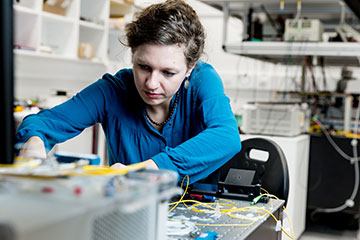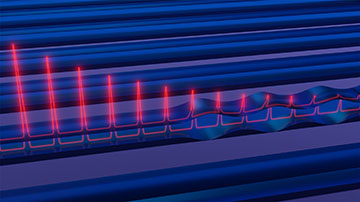
Lead author Birgit Stiller in the laboratory at the Sydney Nanoscience Hub in Australia. [Image: University of Sydney]
Artists and movie directors aren’t the only people fascinated by the interaction of light and sound. Physicists know that, on the size scale of data chips, gigahertz-frequency acoustic phonons can store the optical signals from fiber telecommunications cables without heating up the circuitry. The only catch: these phonons survive for only about 10 nanoseconds.
Researchers in Australia and Germany have learned that blasting the phonons with synchronized light pulses refreshes the acoustic waves, counteracts their decay and prolongs their coherence by about 300%, to 40 ns (Optica, doi:10.1364/OPTICA.386535). This technique could eventually lead to prolonged on-chip signal storage measured in microseconds.
Keeping cool
As anyone who has used a computer knows, traditional microelectronic circuits generate plenty of waste heat. Scientists who are designing the next generation of high-bandwidth information systems want to store data without making the device overheat. The coupling of acoustic phonons with light pulses stores information—without heat-generating electrons—via an effect called stimulated Brillouin scattering.
The team at the University of Sydney, Australia, and Max Planck Institute for the Science of Light (MPL), Germany, studied how an optical “write” pulse converts its signal to an acoustic wave, which propagates through a waveguide at a much lower speed than light. Without further prompting, the signal would decay before it could be detected by an optical “read” pulse. The scientists, led by Birgit Stiller of MPL, used optical “refresh” pulses to transfer energy to the phonons, keeping them going until they could be detected by the optical “read” pulses.

Artist’s conception of the phonons refreshed with light. [Image: Max Planck Institute for the Science of Light]
Stiller, who worked at the University of Sydney until she formed her own research group at MPL, says she was attracted to the challenge of overcoming “an intrinsic limit of the light storage concept: the acoustic lifetime.”
“Trying to come up with a creative setup to outperform our own previous efforts on light storage motivated me a lot,” she adds. The biggest challenge in the work was keeping excellent control of all the parameters of the involved light waves, especially to maintain a decent signal-to-noise ratio.
Testing limits
Since theoretical calculations suggest that the coupling phenomenon could maintain data for at least 350 ns, the team’s next goal is to test the limits of the new scheme experimentally, Stiller says. Extending the waveguide’s length to 2.6 mm might extend the storage time to a microsecond (1000 ns).
Scientists who are now at the University of Southern Denmark and the Australian National University also contributed to this study.
